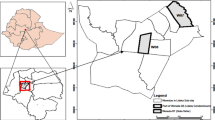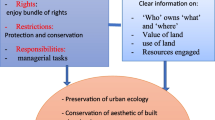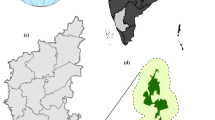Abstract
Buffer zone (BZ) concept has emerged to minimize degradation of natural resources and enhance balanced land use planning for the areas where existing urban and peri-urban landscapes are threatened by rapid land use change. The primary aim of the study is to seek a better understanding of land use planning and governance in BZ surrounding the core zone of the Chittagong Metropolitan Area. Through questionnaires and interviews, the study also identified the key stakeholders’ inclination and influence on land use decisions, i.e., preservation versus urbanization of the BZ. Then, the national and international policies of BZ management were reviewed to check the overall validity and credibility of the analytical results. The results revealed that the respondents in the responsible authorities have demonstrated a positive inclination to urbanization rather than preservation of BZ, whereas non-governmental organizations, practitioners, and academics have supported preservation rather than urbanization. In addition, the study also reported the conflict in interagency and multi-level coordination for urban development. In the national level, core zone development gains more support by containing ‘strategic open space’ and ‘no development zone.’ However, it contradicts the regional plan which allows the reduction of green coverage from 46.20 to 32.56%. Therefore, to achieve BZ management practices in a consistent and sustainable manner, overcoming knowledge and inclination gap, as well as effective coordination of land use governance, is critical.


Source: Interview, adapted from Schmeer (1999)

Source: CDA (2008)

Source: Building Construction Act 2008 (DAP 2009)

Source: DAP (2009)
Similar content being viewed by others
References
Abramson, D. B. (2016). Periurbanization and the politics of development-as-city-building in China. Cities,53, 156–162. https://doi.org/10.1016/j.cities.2015.11.002.
Aguilar, A. G. (2008). Peri-urbanization, illegal settlements and environmental impact in Mexico City. Cities,25(3), 133–145. https://doi.org/10.1016/j.cities.2008.02.003.
Ansari, M. N. A. (2008). Opportunities and challenges of urban and peri-urban forestry and greening in Bangladesh: Dhaka city as a case. Swedish University of Agricultural Sciences (SLU). Retrieved from http://urn.kb.se/resolve?urn=urn:nbn:se:slu:epsilon-s-9008.
Barthel, S., Colding, J., Elmqvist, T., & Folke, C. (2005). History and local management of a biodiversity-rich, urban cultural landscape. Ecology and Society,10(2), 10.
Bentrup, G. (2008). Conservation buffers: Design guidelines for buffers, corridors, and greenways. Asheville, NC: United States Department of Agriculture & Forest Service Southern Research Station.
Bicalho, A. M. D. S. M., & Peixoto, R. T. D. G. (2016). Farmer and scientific knowledge of soil quality: A social ecological soil systems approach. Belgeo,2016(4), 21. https://doi.org/10.4000/belgeo.20069.
BIGD. (2014). State of cities: Governance for a Liveable Chittagong. Dhaka: BRAC Institute of Governance and Development, BRAC University.
BRAPAP. (2011). Project Concept Note Bangladesh REDD + ARR Protected Areas Project. Chittagong.
CDA. (2008). Urban Development Master Plan (2nd ed.). Chittagong: Chittagong Development Authority and Ministry of Housing and Public Works.
Chiesura, A. (2004). The role of urban parks for the sustainable city. Landscape and Urban Planning,68(1), 129–138. https://doi.org/10.1016/j.landurbplan.2003.08.003.
Chowdhury, M. S. H., Gudmundsson, C., Izumiyama, S., Koike, M., Nazia, N., Rana, M. P., et al. (2014). Community attitudes toward forest conservation programs through collaborative protected area management in Bangladesh. Environment, Development and Sustainability,16(6), 1235–1252. https://doi.org/10.1007/s10668-014-9524-y.
CRPARP. (2013). Project implementation manual volume I : General Guidelines of Climate Resilient Participatory Afforestation and Reforestation Project (Vol. I). Bangladesh Forest Department and Arannayk Foundation.
DAP. (2009). Detailed Area Plan for Chittagong Metropolitan City. Government of the People’s Republic of Bangladesh, Ministry of Housing and Public Works, and Chittagong Development Authority (CDA), Bangladesh Government Press, Dhaka.
De Leon, R. C., & Kim, S. M. (2017). Stakeholder perceptions and governance challenges in urban protected area management: The case of the Las Piñas–Parañaque Critical Habitat and Ecotourism Area, Philippines. Land Use Policy,63, 470–480. https://doi.org/10.1016/j.landusepol.2017.02.011.
Douglas, I. (2006). Peri-urban ecosystems and societies: Transitional zones and contrasting values. In D. Mcgregor, D. Simon, & T. Donald (Eds.), The peri-urban interface: Approaches to sustainable natural and human resource use (1 ed., p. 336). London: Routledge. https://doi.org/10.4324/9781849775878
Douglas, I., & Box, J. (2000). The changing relationship between cities and biosphere reserves. The UK-MAB Urban Forum.
Duguma, M., Feyssa, D., & Biber-Freudenberger, L. (2019). Agricultural biodiversity and ecosystem services of major farming systems: A case study in Yayo Coffee Forest Biosphere Reserve, Southwestern Ethiopia. Agriculture,9(3), 48. https://doi.org/10.3390/agriculture9030048.
Ebregt, A., & de Greve, P. (2001). Buffer zones and their Management polices and best practices (series 5). Forests, Forestry and Biological Diversity Support Group, International Agricultural Centre, Wageningen, The Netherlands. Retrieved from papers2://publication/uuid/AE1F55C8-2066-4DCC-B28F-577EB8F78094.
FAO. (2011). Bangladesh Forestry Outlook Study (No. APFSOS II/WP/2011/33). Bangkok. Retrieved from http://www.fao.org/3/a-am628e.pdf.
FEA. (2015). Resource-efficient land use—Towards a Global Sustainable Land Use Standard (GLOBALANDS). Umweltbundesamt. Germany. Retrieved from http://www.umweltbundesamt.de/publikationen/resource-efficient-land-use-towards-a-global.
IPAC. (2012). Integrated Protected Area Co-Management (First Annual Work Plan). Dhaka: USAID.
IPCC. (2014). Climate Change 2014: Mitigation of Climate Change. In O. Edenhofer, R. Pichs-Madruga, Y. Sokona, E. Farahani, S. Kadner, K. Seyboth, J. C. Minx (Eds.), Working Group III Contribution to the Fifth Assessment Report of the Intergovernmental Panel on Climate Change. New York: Cambridge University Press. https://doi.org/10.1017/CBO9781107415416.
Jongman, R. H. G., & Troumbis, A. Y. (1995). The Wider Landscape for Nature Conservation : ecological corridors and buffer zones. ECNC (Vol. MN2.7). Spain. Retrieved from http://library.wur.nl/WebQuery/wurpubs/28667.
Kim, M. (2012). Peri-urbanization and its impacts on rural livelihoods in Mumbai’ s urban fringe. In Peri-urbanization and its impacts on rural livelihoods in Mumbai’s urban fringe 48th ISOCARP Congress (pp. 1–10). Mumbai, India: ISOCARP.
MoEF. (2007). Bangladesh Capacity Development Action Plan for Sustainable Environmental Governance. Ministry of Environment and Forests, Government of the People’s Republic of Bangladesh, Dhaka, Bangladesh, xxii + 252 pp.
MoEF. (2009). Bangladesh Climate Change Strategy and Action Plan. Ministry of Environment and Forests, GoB, xviii + 76 pp. https://doi.org/10.1007/978-4-431-54249-0_7.
MoEF. (2012). Bangladesh Rio + 20: National report on Sustainable Development, (May), 1–116. Retrieved from http://sustainabledevelopment.un.org/content/documents/981bangladesh.pdf.
Mustafa, M. M. E. (2001). A review of forest policy trends in Bangladesh (Vol. 0). Chittagong. Retrieved from http://www.communityforestry.lk/wp-content/uploads/2012/researchpapers/AReviewofForestPolicyTrendsinSriLanka.PDF.
Muzzini, E., & Aparicio, G. (2013). Bangladesh: The path to middle-income status from an urban perspective. Washington, DC: World Bank. https://doi.org/10.1596/978-0-8213-9859-3.
Nilsson, K., Pauleit, S., Bell, S., Aalbers, C., & Nielsen, T. (2013). Peri-urban futures: Scenarios and models for land use change in Europe. (K. Nilsson, S. Pauleit, S. Bell, C. Aalbers, & T. A. Sick Nielsen, Eds.). Berlin Heidelberg: Springer. https://doi.org/10.1007/978-3-642-30529-0.
Pérez-Campuzano, E., Avila-Foucat, V. S., & Perevochtchikova, M. (2016). Environmental policies in the peri-urban area of Mexico City: The perceived effects of three environmental programs. Cities,50, 129–136. https://doi.org/10.1016/j.cities.2015.08.013.
Ravetz, J., Fertner, C., & Nielsen, T. S. (2013). The dynamics of peri-urbanization. In K. Nilsson, S. Pauleit, S. Bell, C. Aalbers, & T. Nielsen (Eds.), Peri-urban futures: Scenarios and models for land use change in Europe (p. 452). Berlin Heidelberg: Springer. https://doi.org/10.1007/978-3-642-30529-0.
Rudel, T. K., Coomes, O. T., Moran, E., Achard, F., Angelsen, A., Xu, J., et al. (2005). Forest transitions: Towards a global understanding of land use change. Global Environmental Change,15(1), 23–31. https://doi.org/10.1016/j.gloenvcha.2004.11.001.
Schmeer, K. (1999). Guidelines for Conducting a Stakeholder Analysis. Rockville, MD: Partnerships for Health Reform.
Schou, J. S., Tybirk, K., Løfstrøm, P., & Hertel, O. (2006). Economic and environmental analysis of buffer zones as an instrument to reduce ammonia loads to nature areas. Land Use Policy,23(4), 533–541. https://doi.org/10.1016/j.landusepol.2005.09.005.
Simon, D., McGregor, D., & Thompson, D. (2006). Contemporary perspectives on the peri-urban zones of cities in developing countries. In D. McGregor, D. Simon, & D. Thompson (Eds.), The peri-urban interface approaches to sustainable natural and human resource use (1st ed., p. 336). UK: Earthscan.
Singh, A. L., & Asgher, M. S. (2005). Impact of brick kilns on land use/landcover changes around Aligarh city, India. Habitat International,29(3), 591–602. https://doi.org/10.1016/j.habitatint.2004.04.010.
Sun, J., Xia, H. P., Lan, C. Y., & Xin, K. (2006). A gradient analysis based on the buffer zones of urban landscape pattern of the constructed area in Guigang City, Guangxi, China. Acta Ecologica Sinica,26(3), 655–662. https://doi.org/10.1016/S1872-2032(06)60012-7.
Trzyna, T., Hyman, G., Mcneely, J. A., Myrdal, B., Phillips, A., Edmiston, J. T., Phillips, A. (2014). Urban Protected Areas Profiles and best practice guidelines. Retrieved from http://cmsdata.iucn.org/downloads/bpg_urban_protected_areas.pdf.
UDMC. (2014). Development of Disaster Management Plan at Upazila Level (CDMP-2 No. 2). Sitakunda, Chittagong.
UNCED. (1992). United Nations Conference on Environment & Development Rio de Janerio, Brazil, 3 to 14 June 1992. United Nations. Rio de Janerio, Brazil. Retrieved from https://sustainabledevelopment.un.org/content/documents/Agenda21.pdf.
UNEP-WCMC. (2014). Man and the Biosphere Reserves (MAB). Retrieved October 29, 2017, from http://www.biodiversitya-z.org/content/man-and-the-biosphere-reserves-mab.pdf.
Vejre, H., Jensen, F. S., & Thorsen, B. J. (2010). Demonstrating the importance of intangible ecosystem services from peri-urban landscapes. Ecological Complexity,7(3), 338–348. https://doi.org/10.1016/j.ecocom.2009.09.005.
Acknowledgements
This research did not receive any specific grant from funding agencies in the public, commercial, or not-for-profit sectors.
Author information
Authors and Affiliations
Corresponding author
Additional information
Publisher's Note
Springer Nature remains neutral with regard to jurisdictional claims in published maps and institutional affiliations.
Rights and permissions
About this article
Cite this article
Al Mamun, M.M., Kim, S.M. Stakeholder analysis matrix for buffer zone management in the peri-urban area of Chittagong, Bangladesh. Environ Dev Sustain 22, 5503–5520 (2020). https://doi.org/10.1007/s10668-019-00435-z
Received:
Accepted:
Published:
Issue Date:
DOI: https://doi.org/10.1007/s10668-019-00435-z





